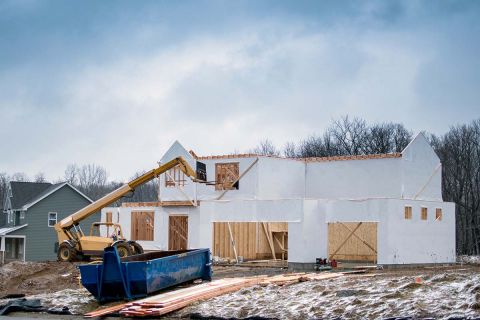Updating Michigan energy rules on new homes faces pushback from builders – Bridge Michigan
Energy Disrupter

“For action on climate change and for energy efficiency, it’s one of the only administrative tools we have to ensure that homes and buildings are really efficient.”
Related:
But Bob Filka, CEO of the Home Builders Association of Michigan, warned that adoption of stricter energy codes would dampen the home-buying market by driving up costs.
“Obviously, the cost of housing is escalating at an alarming rate,” Filka told Bridge in a statement.
“Today’s current building codes are already at a high standard when it comes to energy efficiency requirements. So, how far does government push in making newly constructed homes even more costly?”
Michigan’s home construction energy code is set by the Michigan Department of Licensing and Regulatory Affairs ─ using standards set by the International Energy Conservation Code as an advisory starting point. LARA is free to reject or accept IECC standards, a model code adopted by many states to establish minimum design and construction requirements for energy efficiency.
The proposed IECC standards for Michigan new home construction call for several inches in added ceiling insulation above current standards, more basement wall insulation, tighter air seals around windows and ceilings, rigid foam insulation on all exterior walls, as well as use of LEDs for all light sources.
According to analysis by the U.S. Department of Energy, enactment of the code updates would yield statewide energy savings of nearly 11 percent compared to the current code, and annual utility bill savings of $327 for the average Michigan household.
The analysis estimated the code would cut statewide carbon dioxide emissions over 30 years by more than 11.5 million metric tons ─ equal to the CO2 emissions of 2.5 million cars on the road. It also calculated that it would add more than 11,000 jobs in Michigan over that span, stemming from reduced utility bills and added construction activities.
That calculation comes amid warning signs that climate change ─ driven by rising global, heat-trapping CO2 emissions ─ is already threatening Michigan on fronts that include agriculture, prized trout streams, a possible rise in tick-borne illnesses and powerful storms that are straining the state’s aging infrastructure.
An array of environmental and social justice groups ─ including the Great Lakes Renewable Energy Association, the Michigan Climate Action Network, the Michigan League of Conservation Voters, Detroiters Working for Environmental Justice and the Greater Grand Rapids NAACP ─ urged LARA in a letter to adopt the stricter residential energy code as well as IECC standards for commercial buildings.
“No climate strategy will be successful if it fails to include provisions that target reducing and eliminating building sector emissions,” the letter stated.
A first draft of the home construction energy code is expected in coming weeks, followed by a series of public hearings to hear expected public comment from stakeholders, including construction and trade groups as well as advocates for energy conservation.
LARA expects to issue its final draft by July, which would then be forwarded to the Joint Committee on Administrative Rules, a statutorily created bipartisan legislative committee, composed of five House and five Senate members. JCAR can then either adopt the code as written or send it back to LARA for redrafting.
One expert on energy-efficient home construction told Bridge Michigan he foresees stiff pushback from the Home Builders Association of Michigan on a key piece of the proposed code: the requirement that exterior walls be lined with rigid insulating foam.
“That’s where you get your biggest energy savings. But they will fight that wall insulation to the death,” said Isaac Elnecave of PHIUS, a Chicago-based nonprofit that promotes energy-efficient U.S. home construction.
Elnecave based that view on reaction to a similar provision in the Illinois home construction code that could be poised for rejection, following stiff opposition from building groups.
He pointed to a study of 2018 new home construction in Michigan which found that less than a hundred homes of more than 2,000 surveyed had rigid foam exterior insulation — or less than 5 percent.
“It tells you that, absent a requirement, that builders are only going to do what the code says they have to do,” he said.
Filka of the Home Builders Association of Michigan said he could not comment on any specifics of the code until a final draft of the code is released to the public.
In his email statement, Filka said a stricter energy code might in fact backfire on efforts to conserve energy.
“Advocates for higher standards will say homeowners will see lower energy costs from all these requirements, but those minimal savings are most likely not enough to offset the high upfront expense,” Filka said. “In turn, as fewer people can buy new homes because of costly new requirements, they are forced to live in older less energy efficient homes.”
Filka did not furnish an estimate for how much the proposed energy code might add to the cost of a home.
He added: “We build 16,000 to maybe 17,000 new homes a year in Michigan. There are 4.6 million existing homes (with an average age of more than 50 years) in our state. I believe that math adds up to a focus on less than a third of 1 percent of the residential structures. If they’re trying to lower housing’s impact on the environment, their focus is on the wrong target.”
Environmental groups disagree.
Kate Madigan, director of the Michigan Climate Action Network, a Lansing-based nonprofit advocacy organization, argued there’s no time to put off any measure that will cut greenhouse gas emissions.
“The science is clear that we have to cut climate emissions in half this decade into zero by 2050, to avoid the worst impacts of climate change,” Madigan told Bridge.
“So we really are at the point where we need to do everything that we can and use every tool at our disposal and buildings are a big part of this. And we know that for every dollar we invest in energy efficiency, we see them save more than three dollars in savings and future energy bills,” a perspective that’s backed up by energy-savings programs in Michigan and around the country.
Laprisa Daniels, director of Detroiters Working for Environmental Justice, a Detroit-based nonprofit, said projected utility savings from the proposed code could be critical to low-income households.
“These are households where there is a decision that has to be made as to whether they are putting food on the table or paying for utilities,” Daniels told Bridge. “Any savings is a big deal when you are just trying to get by.”
Habitat for Humanity of Michigan has been building highly-energy-efficient homes for years, above and beyond construction codes. These homes ─ built for low- and moderate-income families who also help construct the homes ─ are typically constructed with insulation, heating efficiency and air-sealing standards that exceed what even the proposed new code would require.
“We kind of smugly joke that a regulation code home is the worst home you can build,” Thom Phillips of Habitat for Humanity of Michigan, told Bridge.
Original Source: https://www.bridgemi.com/michigan-environment-watch/updating-michigan-energy-rules-new-homes-faces-pushback-builders















